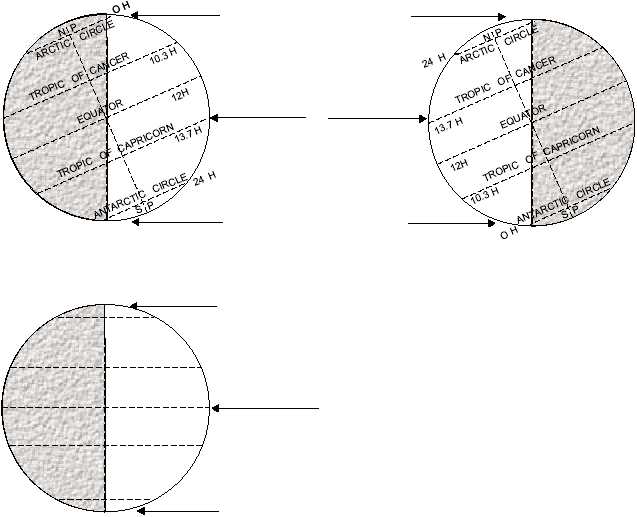climate of an area. These controls, acting in different
combinations and with varying intensities, act upon
temperature, precipitation, humidity, air pressure, and
wind to produce many types of weather and therefore
climate.
Four climatic controls largely determine the
climate of every ocean and continental region. These
controls are latitude, land and water distribution,
topography, and ocean currents. Another factor, which
is now significant in determining a region's climate, is
man. Man’s influence on climate through pollution,
deforestation, and irrigation, is now considered a
climatic factor.
LATITUDE
Perhaps no other climatic control has such a
marked effect on climatic elements as does the latitude,
or the position of Earth relative to the Sun. The angle at
which rays of sunlight reach Earth and the number of
Sun hours each day depends upon the distance of the
Sun from the equator. (See fig. 6-3.) Therefore, the
latitude directly influences the extent to which an air
mass is heated. Latitude influences the sources and
direction of air masses and the weather they bring with
them into a region.
Comparing an equatorial area to a polar area can
show the importance of latitude as a climatic control. In
the former, the Sun is close to being directly overhead
during the day throughout the year. Therefore, there is
little difference between mean temperatures for the
coldest and warmest months. In the polar area,
however, the Sun never rises far above the horizon; that
is, the angle of the Sun to Earth’s surface is always
acute. The radiant energy received per unit area is
therefore slight, and the warming effects of the Sun are
relatively weak.
6-9
6 MONTHS NIGHT
AT N. POLE
TANGENT
SUN RAY
SUN RAY
SUN RAY
SUN RAY
SUN RAY
SUN RAY
SUN RAY
SUN RAY
SUN RAY
TANGENT
TANGENT
TANGENT
TANGENT
TANGENT
PERPENDICULAR
PERPENDICULAR
PERPENDICULAR
12 H
S P
N P
ARCTIC CIRCLE
TROPIC OF CANCER
EQUATOR
TROPIC OF CAPRICORN
ANTARCTIC CIRCLE
12 H
12 H
12 H
12 H
12 H
6 MONTHS
DAY AT N. POLE
6 MONTHS
NIGHT AT S. POLE
6 MONTHS
DAY AT S. POLE
22 DECEMBER - WINTER SOLSTICE
21 - JUNE - SUMMER SOLSTICE
22 SEPTEMBER - AUTUMN EQUINOX
21 - SPRING EQUINOX
POSITION OF PERPENDICULAR AND
TANGENT SUN RAYS DETERMINES
TROPICS OF CANCER AND CAPRICORN
AND ARCTIC AND ANTARCTIC CIRCLES
POSITION OF DAYLIGHT CIRCLE DETER-
MINES LENGTH OF DAY AND NIGHT.
AG5f 0603
Figure 6-3.—Latitude differences in amount of insolation.



